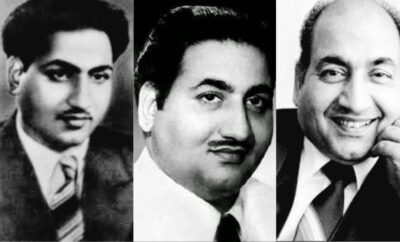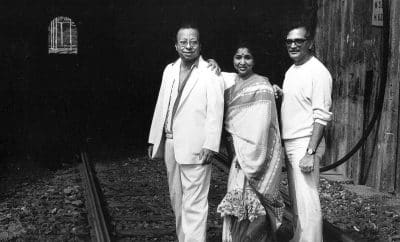Song Sketch
Garjat Barsat – Malhar – Barsaat ki Raat – Double Downpour
Monsoon season – the sweet smell of the earth, misty clouds, the sprightly rivers, green foliage, everything around comes alive and life becomes zestful. They say rain has healing powers. It can wash away your worries and literally cleanse your soul. It lifts your spirits. It also gives us a sense of rejoice. Happiness showering from heaven. As if confetti thrown at earth for celebrating special occasions. For those in love, monsoon brings the yearning of togetherness. The heavy downpour has either the lovers coveting for each other’s company or they celebrate togetherness. One might find countless poems, songs, dramas written on this subject in every language. Folklores, legends depicting stories of monsoon and lovers are an integral part of our tradition. Likewise monsoon and music have a deep association. In Hindustani Classical music there is an entire group of Ragas dedicated to monsoon. Raga Malhar and its family is a champion when it comes to wooing the clouds and flirting with the winds. Malhar being the main Raga and having Megh Malhar, Gaud Malhar, Miyan ki Malhar, Sur Malhar as the principal ragas of the family. They are extremely popular with the composers, musicians and vocalists. Gaud Malhar is the oldest raga amongst the given ragas. It is the confluence of Gaud and Malhar with Thaat Bilawal. Known for its melody and softness, this raga is usually sung at late night or midnight. It is a complete raga –
Mrudu maddhyam teekhe sabai, sampooran vistar
Alp nishad lagaaye ke, gaawat gaud malhar….
Gaud Malhar also happens to be a favourite with music composer Roshan. An emperor of melodies, Roshan, has quite a few songs based on this raga – either completely or you may find traces of it in his songs. The earliest example of him using this raga is in a song from Malhar (1951). Produced by Mukesh, the movie has some beautiful numbers. The song Garjat barsat bheejat aailo….is actually a traditional bandish. Lyricist Indeevar adapted the same style and modulated the song for the film.
Garjat barsat bheejat aailo
Tumre milan ko apne prem piharwa
Lo garva lagaay….
Jo lo hum tum ik dhing rahilo
Toh lo rahilo hiyaraa saman
Sawan aailo laal chunariya
De ho rangaay….
A bandish in teentaal, supported by tabla and flute, a vintage Lata beginning with a flawless aalap form the very essence of the song. Roshan has retained the folksy nature of the bandish. The song is about enjoying the togetherness in monsoon – Jo lo hum tum ik dhing rahilo….in each other’s company or being together.
Almost 9 years later, Roshan again used the bandish (again in teentaal) in Barsaat ki Raat (1960). The lyricist this time is Sahir Ludhianvi. A female duet by Suman Kalyanpur and Kamal Barot, the song is about yearning.
Garjat barsat sawan aayo re
Laayo na sang mein humre bichchade balamwa
Sakhi kaa karun haaye…
Rimjhim rimjhim meha barse
Tadpe jiyarwa meen samaan
Pad gayi phiki laal chunariya, piya nahi aaye…
Pal pal chhin chhin pawan jhakore
Laage tan par teer samaan
Nainan jal so bheegi sajariya, agan lagaaye….
Sahir being Sahir, he describes the yearning of heart and the physical yearning too. The song is picturised on Shyama and Ratna Bhushan. Roshan has beautifully used the jaltarang, sarod and sarangi throughout the song.
Both songs are similar yet different, both used at the titles of the respective films, one solo, the other duet. The later version, which is popular, is embellished with more instruments while the original version sounds more rustic. A double downpour through Roshan, truly reverberates thunder and sends ripples of rain to the listener echoing yearning and togetherness at the same time.




Pratik
July 15, 2024 at 3:14 am
What a beautiful write up. Got so much to learn about raags and the two songs composed on the same raag. Beautifully explained and detailed. Loved it 😊
Deepa
July 23, 2024 at 1:10 pm
Thank you. Both the songs are beauties in their own sense.